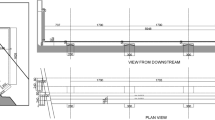Abstract
Numerical modeling of hydraulic phenomenon by computational fluid dynamic (CFD) approaches is one of the main parts in the high cost hydraulic structure studies. In this paper, using Flow 3D as CFD commercial tool, the cavitation phenomenon was assessed along spillway's flip bucket of the Balaroud dam. Performance of numerical modeling was compared to the physical model, which was constructed to this purpose. During numerical modeling, it was found that RNG turbulence model is a suitable performance for modeling the cavitation. Physical modeling shows that minimum cavitation index is about 0.85 and minimum cavitation index based on Flow 3D results is about 0.665, which was related to the flood discharge with return period of 10000 years. The main difference between numerical and physical modeling is related to the head of velocity, which is considered in physical modeling. Results of numerical simulation show that occurrence of cavitation based on cavitation index equal to 0.25 is not possible along the spillway.
Similar content being viewed by others
References
Ettema R. Hydraulic Modeling: Concepts and Practice. ASCE, 2000
Chau K W. Modelling for Coastal Hydraulics and Engineering. Taylor & Francis, 2010
Fattor C, Bacchiega J. Design Conditions for Morning-Glory Spillways: Application to Potrerillos Dam Spillway. In: Advances in Water Resources and Hydraulic Engineering, Springer Berlin Heidelberg. 2009, 2123–2128
Gourbesville P, Cunge J, Caignaert G. Advances in Hydroinformatics: SIMHYDRO 2012–New Frontiers of Simulation. Springer Singapore Pte. Limited, 2013
Parsaie A, Haghiabi A. The effect of predicting discharge coefficient by neural network on increasing the numerical modeling accuracy of flow over side weir. Water Resources Management, 2015, 29(4): 973–985
Parsaie A, Yonesi H, Najafian S. Predictive modeling of discharge in compound open channel by support vector machine technique. Modeling Earth Systems and Environment, 2015, 1(2): 1–6
Parsaie A, Haghiabi A, Moradinejad A. CFD modeling of flow pattern in spillway’s approach channel. Sustainable Water Resources Management, 2015, 1(3): 245–251
Parsaie A, Haghiabi A. Computational Modeling of Pollution Transmission in Rivers. Applied Water Science, 2015, 1–10
Parsaie A, Haghiabi A. Predicting the longitudinal dispersion coefficient by radial basis function neural network. Modeling Earth Systems and Environment, 2015, 1(4): 1–8
Parsaie A, Yonesi H, Najafian S. Predictive modeling of discharge in compound open channel by support vector machine technique. Modeling Earth Systems and Environment, 2015, 1(1–2): 1–6
Kim D, Park J. Analysis of flow structure over ogee-spillway in consideration of scale and roughness effects by using CFD model. KSCE Journal of Civil Engineering, 2005, 9(2): 161–169
Gessler D. CFD modeling of spillway performance. In: Proc. World Water and Environmental Resources Congress. May, 2005
Aydin M C. CFD simulation of free-surface flow over triangular labyrinth side weir. Advances in Engineering Software, 2012, 45(1): 159–166
Johnson M C, Savage B M. Physical and numerical comparison of flow over ogee spillway in the presence of tailwater. Journal of Hydraulic Engineering, 2006, 132(12): 1353–1357
Chanson H. Design of weirs and spillways, in Hydraulics of Open Channel Flow. 2nd ed. Chanson H, 2004, Oxford: Butterworth-Heinemann, 2004, 19: 391–430
Wu J, Ma F. Cavity flow regime for spillway aerators. Science China Technological Sciences, 2013, 56(4): 818–823
Dong Z Y, Chen L, Ju W J. Cavitation characteristics of high velocity flow with and without aeration on the order of 50 m/s. Journal of Hydrodynamics. Ser. B, 2007, 19(4): 429–433
Chatila J, Tabbara M. Computational modeling of flow over an ogee spillway. Computers & Structures, 2004, 82(22): 1805–1812
Toloshinov A V, et al. Development of the design for the No. 2 spillway at the Boguchany hydroproject. Power Technology and Engineering, 2009, 43(3): 135–142
Szymkiewicz R. Numerical Modeling in Open Channel Hydraulics. Springer, 2010
Kirkgoz M S, Akoz M S, Oner A A. Numerical modeling of flow over a chute spillway. Journal of Hydraulic Research, 2009, 47(6): 790–797
Lv J, Liu M. Research to the Stilling Basin Types of the Spillway Outlet. In: Advances in Water Resources and Hydraulic Engineering. Springer Berlin Heidelberg, 2009, 1536–1540
Aydin M C, Ozturk M. Verification and validation of a computational fluid dynamics (CFD) model for air entrainment at spillway aerators. Canadian Journal of Civil Engineering, 2009, 36(5): 826–836
Erfanain-Azmoudeh M H, Kamanbedast A A. Determine the appropriate location of aerator system on Gotvandoliadam’s spillway using Flow 3D. American-Eurasian Journal of Agricultural & Environmental Sciences, 2013, 13(3): 378–383
Chanel P G, Doering J C. Assessment of spillway modeling using computational fluid dynamics. Canadian Journal of Civil Engineering, 2008, 35(12): 1481–1485
Author information
Authors and Affiliations
Corresponding author
Rights and permissions
About this article
Cite this article
Parsaie, A., Dehdar-Behbahani, S. & Haghiabi, A.H. Numerical modeling of cavitation on spillway’s flip bucket. Front. Struct. Civ. Eng. 10, 438–444 (2016). https://doi.org/10.1007/s11709-016-0337-y
Received:
Accepted:
Published:
Issue Date:
DOI: https://doi.org/10.1007/s11709-016-0337-y




